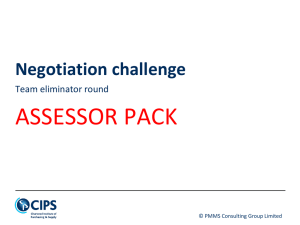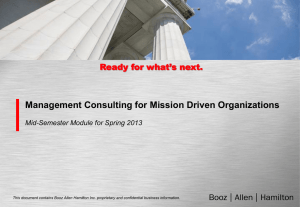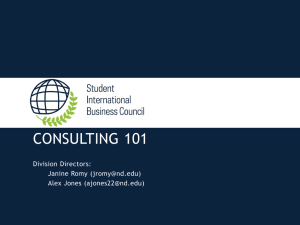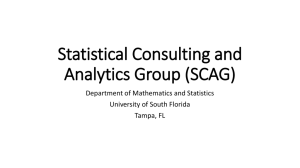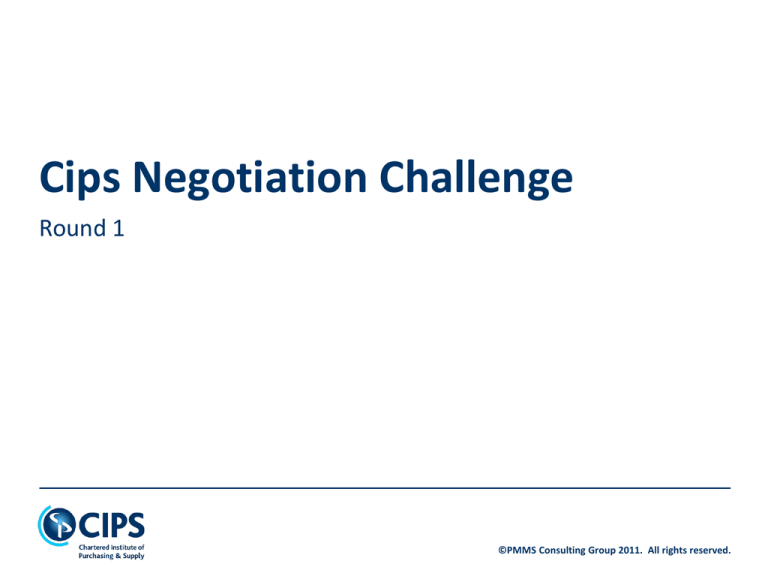
Cips Negotiation Challenge
Round 1
©PMMS Consulting Group 2011. All rights reserved.
Negotiation – A definition
A process through which parties move from their
initially divergent positions to a point where
agreement may be reached
©PMMS Consulting Group 2011. All rights reserved.
HOUSE OF
NEGOTIATION
©PMMS Consulting Group 2011. All rights reserved.
The warm and tough approach
Warm
Warm and tough
Assertion
Value and respect
Good communicator
Easy
Tough
Cold
©PMMS Consulting Group 2011. All rights reserved.
17th birthday – persuasion
practice session
• Both groups have 10 minutes to prepare for the
negotiation.
• Each group list all the variables you may need in order
to persuade the other party to your way of thinking.
Remember you can’t make the other party agree but you
can persuade them.
©PMMS Consulting Group 2011. All rights reserved.
17th birthday – persuasion
practice session
•
•
Team A = Parents
Team B = Teenagers approaching 17th birthday
•
Parents - You are looking forward to your son/daughters 17th birthday. You have
already told them that you have bought them a series of driving lessons. You feel
this is an extravagant present as most teenagers have to work and pay for their own
lessons.
•
Teenagers - You are grateful for receiving driving lessons and appreciate how hard
your parents work. However, ALL your friends get driving lessons plus a car for their
17th. You express how you feel and work to persuade your parents you should have
a car too.
©PMMS Consulting Group 2011. All rights reserved.
Using Emotion
• Be in control of your emotions – don’t let them
control you!
• Use from a sincerely held belief
• Use early in the negotiation
• Use to increase the “perceived value” of your
bargaining
• Use to counter logic
©PMMS Consulting Group 2011. All rights reserved.
Using logic
•
•
•
•
•
•
Don’t be too quick to ask “Why?”
Get your own logic in first
Keep to one powerful argument – don’t dilute
Be credible
If others can’t see it, change tack
Counter logic with emotion
©PMMS Consulting Group 2011. All rights reserved.
Using threat
•
•
•
•
•
•
Be slow to threaten
Threaten at the business, not the person
Use a discreet or veiled threat
Never make a threat you can’t …..
Be credible
Add “if” to transfer threat to bargaining
©PMMS Consulting Group 2011. All rights reserved.
Using bargaining
•
•
•
•
•
•
Don’t expose your position early
Don’t put a marker down
Don’t seem too eager to move
Move, in small steps,
Get a return for any concession you make
Thank and bank
©PMMS Consulting Group 2011. All rights reserved.
Using compromise
The behaviour of last resort
• 50/50 is not the only compromise
• Compromise favours the more extreme party
• Let the other party suggest compromise…
…..the one suggesting compromise probably accepts or
moves towards the position of the other…..
©PMMS Consulting Group 2011. All rights reserved.
The negotiation cycle
Preparation
& Planning
Reviewing
Opening
Concluding
Testing
Moving
©PMMS Consulting Group 2011. All rights reserved.
The negotiation cycle
Flipchart interactive exercise
©PMMS Consulting Group 2011. All rights reserved.
Preparation and planning
The objective here is….
To place you in the best possible position before the
negotiation commences
Preparation ………researching the issues
Planning ….strategy, tactics, logistics
©PMMS Consulting Group 2011. All rights reserved.
Preparation and planning
objective setting
We need to set clear targets for each variable
• IDEAL
Our ideal settlement, we strive to achieve it – our AIM HIGH figure or
STRETCH target!
• REALISTIC
Realistically we feel that this is where we might finish up!
• FALLBACK
The point beyond which it is not commercially viable to do business
Plan to be flexible as objectives may need to be changed
©PMMS Consulting Group 2011. All rights reserved.
Opening
The Vital First Impression
• Timekeeping
• Politeness
• Physical appearance and
dress
• Personal hygiene
•
•
•
•
The hand shake
Eye contact
Smile
The opening words
©PMMS Consulting Group 2011. All rights reserved.
Testing
• To test the validity of the assumptions we have made
• To see where movement in the other party is likely to
come from
• To understand what is likely to be expected of us
©PMMS Consulting Group 2011. All rights reserved.
Testing – questioning techniques
Types of question
• Open
• Closed
• Probing
• Multiple
• Leading
• Reflective
• Hypothetical
©PMMS Consulting Group 2011. All rights reserved.
Moving
To achieve the maximum movement from the other
party and make minimum movement yourself, in
relation to your targets
©PMMS Consulting Group 2011. All rights reserved.
Encouraging movement
• Progressive and enthusiastic summary
“So we’re agreed on the menus and the opening hours we’re getting through it, let’s move on”
• Thank and bank
“Thank you. I appreciate it. Can we move on to…”
“Thanks for that, I do appreciate the offer, it’s a good
move, however could you look again at…”
©PMMS Consulting Group 2011. All rights reserved.
Concluding
• To reach a workable agreement
• To record what has been agreed
• To agree the next steps
• To condition for next time
©PMMS Consulting Group 2011. All rights reserved.
Review
•
•
•
•
•
•
comparison with ‘SMART’ targets
extent of plan achieved
what went well / what didn’t
what could I have done better
hard and soft successes
personal, team, organisation or industry patterns
©PMMS Consulting Group 2011. All rights reserved.
Learning review
• Share two key learning points
©PMMS Consulting Group 2011. All rights reserved.


